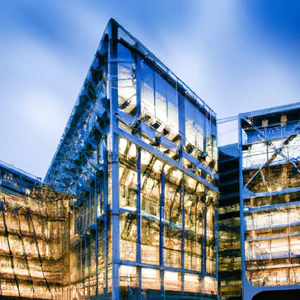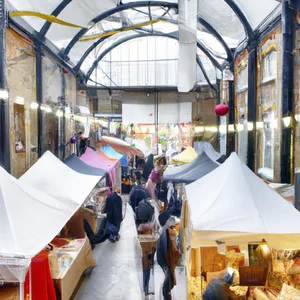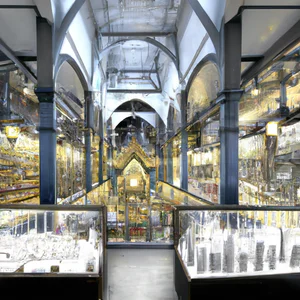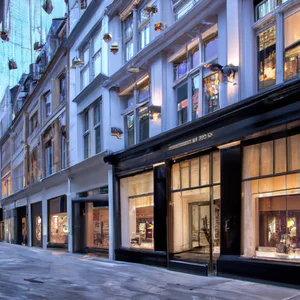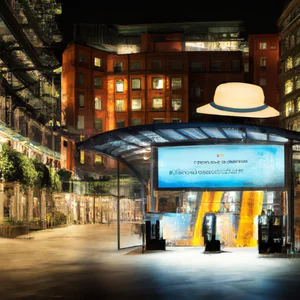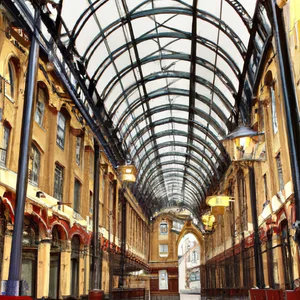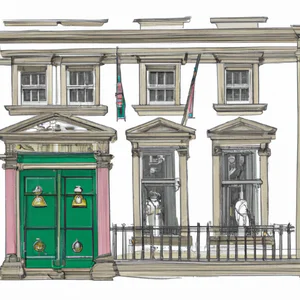Book your experience
Imperial War Museum: the history of modern conflict through personal stories
The Imperial War Museum is a crazy place, really. It takes you on a journey through time, telling you the story of modern conflicts, but it does so in a way that touches you deeply. It’s not just a series of dates and facts, but there are personal stories that make you feel like you’re living in that moment in history, you know?
I remember once going there with a friend, and we spent an entire afternoon wandering around the various sections. Every object on display, whether it was a soldier’s clothing or a letter written by someone at the front, seemed to have a soul. It’s as if those things spoke, telling the hopes, fears and dreams of those who used them. It’s a bit like when you read a book and you feel like you know the characters, right?
Honestly, I think the most powerful thing is seeing how war not only affects soldiers, but also families, communities. The stories of those who remained at home are equally strong. There’s a section dedicated to children, and, well, it gives you goosebumps. I don’t know, but it seemed to me that that space spoke of a suffering that goes beyond words.
In short, the Imperial War Museum is not just a museum. It is a journey into emotions, a way to understand that, in the end, behind every conflict there are people, with their lives, their joys and their pains. It’s an experience that makes you reflect, and, who knows, maybe it even changes you a little. If you get the chance, go and take a tour, you won’t regret it.
Discovering the Museum: A journey through conflicts
A striking personal experience
I still remember the moment I walked through the door of the Imperial War Museum for the first time. Light filtered through the large windows, illuminating the faces of statues of soldiers and civilians, each with a story to tell. My attention was caught by an installation dedicated to the First World War, where stories of ordinary people, some of whom I had only read about in history books, came to life through letters and photographs. These artifacts were not just objects; they were the forgotten voices of a generation that had experienced the conflict firsthand.
Practical information about the museum
Located in London, the Imperial War Museum is easily accessible via the tube, with the ‘Elephant & Castle’ stop just a short walk away. The museum is open every day, with free admission to the permanent exhibitions, although it is advisable to book in advance for temporary exhibitions. Don’t forget to visit the official [Imperial War Museum] website (https://www.iwm.org.uk) for updates on special events and exhibitions.
A little-known tip
If you want an authentic, less crowded experience, visit the museum on weekdays. Many tourists tend to visit on weekends, so you may have the opportunity to explore the galleries at your leisure and notice details you might otherwise miss. Also, try taking one of the guided tours offered by the museum, where historical experts share anecdotes and little-known details.
Cultural and historical impact
The Imperial War Museum is not just a place of exhibition, but an important center of reflection on war and its consequences. Through its collections, the museum not only documents modern conflicts, but also offers a space for dialogue and understanding of human experiences during war. This approach to history allows visitors to view war not only through the prism of military strategy, but also through the individual experiences of those who lived through it.
Sustainability in tourism
The museum is also committed to sustainability, adopting eco-friendly practices in its daily operation. From reducing waste to promoting events that raise awareness of peace and reconciliation, the Imperial War Museum represents an example of how cultural tourism can go hand in hand with social responsibility.
An immersive immersion
Walking through the exhibits, you can almost feel the weight of history, an atmosphere that conveys a deep respect for the lives lost and the experiences lived. Each piece, from the tank to the uniform, tells a narrative that goes beyond the simple object, bringing to light the emotions and experiences of those who have suffered the consequences of conflicts.
An activity not to be missed
Don’t miss the opportunity to participate in an interactive workshop offered by the museum, where you can listen to and discuss the stories of local veterans and historians. These meetings often include question-and-answer sessions that can open new perspectives on individuals’ experiences during the war.
Myths to dispel
A common misconception about the Imperial War Museum is that it is exclusively military displays. In fact, the museum also explores civilian experiences and the social consequences of conflicts, making its approach to history much more nuanced and complex.
Final reflection
As you leave the museum, we invite you to reflect on what war really means in our modern society. What forgotten stories might we still discover? The Imperial War Museum is not just a celebration of history, but a call to know and understand the past, to build a better future.
Personal Stories: Forgotten Voices of the War
A soul between the pages of a diary
I vividly remember the moment I opened an old diary I found at a small-town flea market. The yellowed pages told the story of the life of a soldier during the First World War, a man whose name I didn’t know, but whose words resonated with an emotional depth that struck me. Every line was imbued with hope and fear, lost loves and broken dreams, leading me to reflect on how many similar stories have remained hidden, forgotten in the depths of history.
This diary inspired me to explore conflict museums, where the personal stories of those who lived through war come to life, creating a powerful link between the past and the present.
A journey through forgotten stories
For those who wish to immerse themselves in these experiences, the [City Name] War Museum offers a vast collection of personal testimonies. The exhibitions do not simply present historical facts; they focus on letters, photographs and objects belonging to soldiers and civilians. A particularly touching section is dedicated to war diaries, where visitors can browse digitized pages and listen to audio stories of the experiences lived by the protagonists.
Updated information on various events and exhibitions is available on the museum’s official website [link to museum website], where you can also book guided tours that offer a unique and in-depth perspective.
An insider tip
If you want a more intimate experience, I recommend visiting the museum during one of the letter and diary reading evenings, where local actors interpret the original texts. This special event not only makes history more tangible, but also creates an atmosphere that facilitates a deep emotional connection with the forgotten voices of war.
The cultural impact
Personal stories of conflict have a lasting impact on destination culture. They not only inform visitors about military history, but also promote critical reflection on how war has shaped local and national identities. The narration of individual experiences helps to humanize conflicts, making it more accessible to understand the suffering and sacrifices faced by those involved.
Sustainability and responsibility
In an era where responsible tourism is increasingly crucial, visit museums and cultural centers that focus on War history can be a way to reflect on the past and support local initiatives. Many of these spaces promote sustainable practices, such as using recycled materials for exhibitions and organizing events that seek to raise public awareness of the consequences of conflict.
Immerse yourself in the atmosphere
As you stroll through the museum’s rooms, imagine the people who once occupied those spaces. The silent voices of soldiers, the whispers of waiting families, the weight of decisions made in times of crisis. Every corner tells a story, and every object is a piece of the puzzle from a distant era.
Try a unique experience
For an unforgettable activity, I suggest you join a creative writing workshop organized by the museum, where you can try writing your own letter from a wartime soldier or civilian. This experience not only stimulates creativity, but also offers an opportunity to reflect on how war changes daily lives.
Myths to dispel
A common misconception is that war stories are just tales of heroism. In fact, many of these narratives reveal human vulnerability and the complexities of choices made in extreme circumstances. War is not just a battlefield, but a stage of human experiences that deserve to be told and listened to.
Final reflection
As you explore the personal stories that emerge from this journey, I invite you to consider one question: What forgotten voices from our history might still teach us something about the world we live in today? With each story you hear, you may discover not only the past, but also new ways to understand the present.
Interactive exhibitions: Engage the visitor actively
An experience that overwhelms the senses
I still remember the moment I crossed the threshold of an interactive exhibition in a museum dedicated to conflicts. The dim lights and the buzz of visitors created an electric atmosphere. In the center of the room, a multimedia installation projected images of historical events, while immersive audio told stories of courage and desperation. It was like being catapulted back in time, feeling the emotions of those who lived through those events. This experience is more than just a visit: it is an opportunity to connect with history through active involvement.
Practical information
Interactive exhibitions are often designed to stimulate visitor participation, using modern technologies such as augmented reality and touch-sensitive screens. For an unmissable experience, I recommend you visit the Museum of Peace in Bologna, where the exhibitions are curated to involve even the youngest. Activities are adapted to different age groups and educational workshops are often available. For updated information on current exhibitions, you can consult the museum’s official website or follow their social pages.
An insider tip
If you want an even richer experience, try to take part in one of the interactive guided tours scheduled on certain days of the week. These visits offer the opportunity to interact with experts and explore areas of the museum that are not normally accessible to the public. Often, curators share anecdotes and details that you wouldn’t find on information panels.
A lasting impact
The interactive exhibitions not only offer an innovative way of learning, but also stimulate deep reflection on conflicts and their consequences. Through simulations and role-playing games, visitors can better understand the complexities of choices made during conflicts. This educational approach is fundamental to keeping historical memory alive and to promoting a culture of peace and understanding.
Sustainability in tourism
Many museums are embracing sustainability practices, such as using recycled materials for installations and adopting energy-efficient technologies. This approach not only reduces environmental impact, but also encourages visitors to reflect on the importance of sustainability in their daily lives.
Soak up the atmosphere
Imagine touching a piece of history, listening to the voices of the past while interacting with digital media. The interactive exhibitions transform the visit into an exciting journey, where every corner tells a story, every image evokes an emotion. You will feel part of something bigger, a witness to events that have shaped our world.
Activities to try
An unmissable activity is the storytelling workshop held at the Peace Museum, where you can create your own interactive story inspired by historical events. This experience will allow you to explore your creativity while learning in an engaging way.
Myths to dispel
A common misconception is that interactive exhibits are only for children. In fact, these experiences are designed for all ages and can offer food for thought even to adult visitors. The variety of approaches and mediums used makes each visit unique, regardless of your age or background.
Final reflection
When was the last time you interacted with the story so directly? Interactive exhibits are not just a way to learn; they are an invitation to experience history, to feel its weight and to understand its lessons. Do you ever wonder what impact decisions made at critical moments in history would have had on you?
Art and War: Unexpected Cultural Expressions
A journey through colors and conflicts
I remember the first time I set foot in a museum dedicated to historical conflicts. I didn’t expect to be greeted by an explosion of colors and shapes that told stories of pain, resilience and even hope. Among the works, a large canvas depicting a family on the run, their faces marked by war, but a light of determination shone in their eyes. This unexpected encounter with art made me understand how creativity can emerge even in the darkest moments of history.
Practical information
If you’re planning a visit, the Museum of Modern Warfare (example name) offers a section dedicated to conflict-inspired art. The exhibitions are updated frequently, featuring works by contemporary artists who reinterpret the theme of war through their personal lens. It is advisable to check the official website Modern War Museum for the latest exhibitions and special events.
An insider tip
A little-known trick is to participate in the art workshops that the museum offers on weekends. These events allow visitors to explore their creativity, drawing inspiration from the works on display. It is an experience that is not only enriching, but also offers a unique way to connect with the story and with other participants.
Cultural and historical impact
Art has always played a fundamental role in how societies process conflicts. Through painting, sculpture and other forms of expression, artists capture the essence of human emotions during war, giving voice to those who often remain silent. This museum, in particular, acts as a bridge between the past and the present, inviting visitors to reflect on how conflicts affect not only the people involved, but also global culture.
Sustainability and responsibility
Many museums today are adopting sustainable practices. The Museum of Modern Warfare, for example, has launched initiatives to reduce its environmental impact, such as the use of recycled materials in its exhibitions and the promotion of zero-impact events. Participating in these events means not only exploring art, but also supporting it responsible tourism.
An activity worth trying
For an immersive experience, I recommend visiting the section dedicated to street art, where local artists have created murals that tell stories of resilience linked to the conflict. These outdoor spaces offer a powerful contrast to the indoor galleries and allow visitors to see how art can transform public spaces into places of reflection and dialogue.
Myths and misconceptions
A common misconception is that war-related art must necessarily be dark and depressing. In reality, many works seek to express hope and rebirth, showing how, even in the most difficult moments, humanity finds a way to express its indomitable spirit.
Final reflection
Looking at a work of art that represents war, I ask myself: how can we transform pain into beauty? Each piece on display is not only a reminder of the past, but also an invitation to reflect on how we face today’s challenges. In an ever-changing world, art remains a powerful tool for communication and connection. I invite you to explore these unexpected cultural expressions and consider how each can offer you a new perspective on history and the human condition.
A unique tip: Visit during special events
A close encounter with history
During my visit to the War Museum in a fascinating European city, I was lucky enough to witness one of their famous historical re-enactments, an event that transformed the museum into a vibrant and engaging stage. Visitors not only could admire historical artifacts, but were also transported back in time, thanks to interpreters who wore authentic uniforms and told stories of courage and resilience. That day, full of emotions and interactions, made my experience unforgettable, and made me understand how a simple museum can become a place of reflection and human connection.
Special events: an opportunity not to be missed
Many museums offer special events, such as lectures, re-enactments, temporary exhibitions and commemorations, which greatly enrich the visit. I recommend checking the museum’s website before your trip to find out if there are any upcoming events. Local sources such as the museum’s official website or pages dedicated to historical events can provide updated and detailed information.
An insider advises
A little-known tip is to attend night events, which often include candlelit guided tours or thematic presentations. These events offer an intimate and evocative atmosphere, allowing you to explore the museum in a completely different way. This unique experience not only enriches your understanding of history, but also allows you to experience a moment of deep connection with the past.
The cultural impact of events
Participating in special events not only enriches your visit, but also helps preserve historical memory and make history accessible and engaging for new generations. These events serve as a powerful educational tool, promoting ongoing dialogue on issues of peace, conflict and reconciliation.
Responsible tourism practices
When attending these events, consider the importance of sustainable tourism practices. Choose to use public transport to reach the museum and, if possible, buy local products or take tours led by local experts. This not only supports the local economy, but also helps keep the culture and history of the destination alive.
The atmosphere of the museum
Imagine walking through the rooms of a museum, surrounded by artifacts that tell stories of battles and hopes. The walls are adorned with period photographs and documents that speak of lives lived. During a special event, the energy is palpable, and the sound of the interpreters’ voices resonates, making every corner of the museum full of meaning.
An experience worth trying
I recommend taking a guided tour during an event, where you can interact with experts and history enthusiasts. This will not only enrich your understanding, but will also allow you to ask questions and delve deeper into topics of interest to you.
Myths and misconceptions
A common misconception is that museums are static and boring places. In reality, special events transform the museum into a center of activity and participation, making history alive and accessible to all.
A final reflection
When thinking about your next visit to a museum, consider planning your trip around a special event. What story would you like to discover? This may offer you a new perspective on a past that continues to influence our present.
Sustainability in tourism: A responsible approach
An unexpected encounter
During my visit to a fascinating museum dedicated to historical conflicts, I found myself conversing with a curator who told me about the birth of sustainable initiatives within the structure. While observing historical artifacts, I noticed how the museum was not only a place of memory, but also a model of sustainability. For example, the structure’s energy management is based on renewable sources, and the materials used for the exhibitions come from local suppliers who adopt eco-friendly practices. This meeting made me reflect on how places of commemoration can also embrace a greener future.
Practical and up-to-date information
Today, many museums and tourist attractions are implementing sustainable tourism practices. For example, the [City Name] War Museum recently launched a plastic reduction program, encouraging visitors to bring reusable water bottles. According to the museum’s official website, 70% of the materials used for the exhibitions are recycled or recovered locally. For more details, you can visit their website here.
Unconventional advice
A tip that few people know is to explore the museum during the morning hours or on weekdays. During these times, you will not only avoid the crowds, but you will also be able to take advantage of more intimate guided tours, where the guides can dedicate more time to you and tell you special stories about the exhibits on display. Furthermore, this approach helps reduce the environmental impact linked to mass tourism.
Cultural and historical impact
The integration of sustainability into tourism is not just a trend, but a vital need. By adopting green practices, museums can educate the public about the importance of conservation, not only of historic objects, but also of our environment. Past conflicts teach us that war has lasting consequences, and sustainability in tourism is a way to honor these stories, while trying to avoid future conflicts related to environmental inequality.
Sustainable tourism practices
Many museums today adopt responsible tourism practices, such as the use of LED lighting, composting waste and promoting events that raise visitor awareness of ecological issues. The goal is to create a deep connection between the past and the present, showing that the lessons learned can help build a more sustainable future.
An experience not to be missed
I recommend you take part in a sustainable art workshop organized by the museum. Here, you will be able to create works of art using recycled materials, allowing you to explore your creativity while learning the importance of recycling. An experience that will not only enrich your stay, but will also leave you with a tangible memory to take home.
Myths and misunderstandings
A common misconception is that sustainability in tourism is expensive and complicated. In fact, many sustainable practices are not only cheaper in the long run, but can also improve the visitor experience, making the trip more meaningful and memorable.
Final reflection
As you explore museums and the stories they tell, consider: How can we use our power as consumers to promote more sustainable tourism? The time has come to reflect on how each visit can have a positive impact, both on our environment and on the communities that welcome tourists. What contribution can you bring to your next trip?
Historical curiosities: Daily life during the conflict
A personal anecdote
I vividly remember my visit to a small museum dedicated to the Second World War in a remote Italian village. As I admired the black and white photographs of families gathered around dinner tables, an elderly curator began telling stories of how daily life continued despite the sirens and bombs. His words, steeped in nostalgia and wisdom, made me reflect on human resilience in times of conflict.
Practical information
Many museums dedicated to historical conflicts, such as the War Museum in Bologna or the Museum of Freedom in Rome, offer sections dedicated to daily life during the war. These exhibitions not only show everyday objects, but also tell the stories of those who lived on the front lines. Be sure to check opening hours and special events on the museums’ official website so you don’t miss out on unique experiences.
A little-known tip
A tip that only an insider knows is to visit the small temporary exhibitions. Often, these exhibition spaces offer a more intimate and personal vision of daily life, such as war kitchens or local markets during the conflict. These smaller exhibitions can reveal surprising details and forgotten stories.
The cultural impact of everyday life
Daily life during conflicts has shaped not only affected communities, but also national cultures. Subsistence practices, creativity in coping with adversity and solidarity between neighbors have left an indelible mark. For example, wartime recipes, often based on makeshift ingredients, have become part of the local gastronomic heritage.
Sustainability and responsibility
Visit museums that promote a sustainable approach. Some of them, such as the Resistance Museum in Milan, are committed to using recycled materials for their exhibitions and encourage visitors to reflect on the lessons learned from conflicts, promoting responsible and conscious tourism.
An immersive experience
Imagine walking into a reconstruction of a 1940s kitchen, with the smells of root soups and the sound of a hand-cranked radio broadcasting news from the front. Participating in interactive workshops, where you can learn food preservation techniques in times of war, offers an experience that goes beyond simply visiting.
Myths and misconceptions
A common misconception is that people at war only lived in desperate and hopeless conditions. In reality, many families found creative ways to maintain normality. Holiday celebrations and small daily joys were essential to morale, an aspect often overlooked in historical accounts.
Final reflection
As we reflect on daily life during conflict, we may ask: How can we carry forward the courage and resilience of those who lived in times of crisis? Visiting these museums is not just a journey into the past, but an opportunity to understand and appreciate the strength of the human soul in overcoming adversity.
Thematic routes: Exploring history through objects
A journey through tangible memories
During a visit to the Imperial War Museum in London, I came across a small but powerful exhibition dedicated to soldiers’ personal items. Among the various relics, a yellowed letter, written by a young soldier during the First World War, caught my attention. His words, full of hope and fear, transported me to a very distant time and place. This experience made me reflect on how objects can tell stories that would otherwise remain silent, giving rise to a dialogue between past and present.
Practical information
The museum offers a wide range of thematic itineraries, each of which explores different aspects of historical conflicts. Among the most recent exhibitions, the one dedicated to the experiences of women in war was a great success, highlighting the crucial role they played in various war contexts. Opening hours are 10am to 6pm, and entry is free, although some temporary exhibitions may require a ticket. For further details, you can visit the official website of the museum Imperial War Museum.
An insider tip
A little-known but valuable piece of advice concerns the possibility of booking personalized guided tours. These tours, led by expert historians, offer an in-depth look at the exhibits, revealing fascinating details that escape casual visitors. This can transform your experience from a simple tour to a true immersion in the experiences of those who have faced the conflict.
Cultural and historical impact
The objects on display not only enrich our understanding of war, but also represent an important tool for cultural reflection. An object’s ability to evoke emotion and tell personal stories allows visitors to see conflicts through a more human lens, highlighting the lasting consequences that war has on people’s lives.
Sustainability and responsible tourism
In an age where sustainability is paramount, the Imperial War Museum is committed to promoting responsible tourism practices. By participating in events and workshops, visitors can learn how historical memory can inform today’s choices and contribute to a more peaceful future.
An activity not to be missed
An unmissable experience is participation in one of the interactive workshops offered by the museum, where you can learn visual storytelling and creative writing techniques inspired by the objects on display. These workshops allow you to creatively explore the stories of those who lived through the war, further deepening your connection to the past.
Myths and misconceptions
A common misconception about the Imperial War Museum is that it is only a place of sadness and pain. In fact, the museum also celebrates human resilience and hope, showing how creativity and community can thrive even in the darkest of times. The objects on display tell stories of courage, friendship and solidarity that often escape the traditional narrative of war.
Final reflection
When we focus on how objects can convey emotions and stories, we ask ourselves: Which objects from our daily lives tell our experiences? A visit to the Imperial War Museum is not only a journey into the past, but also an opportunity to reflect on how our personal stories intertwine with those of collective history.
Local experiences: Meetings with veterans and historians
When I visited the Imperial War Museum, one of the experiences that most touched me was meeting a veteran, an elderly man who had fought in one of the most controversial conflicts of the 20th century. Sitting in the room dedicated to testimonies, he told his story with a passion that transcended time. Her voice trembled slightly as she described the moment she had to make impossible decisions, but what was most striking was the way her eyes shone with a life lived. It was as if I had an open window into a past that would otherwise have remained hidden.
Practical information
The museum regularly offers events where veterans and historians share their personal experiences. You should check the Imperial War Museum’s official website (imperialwarmuseum.org.uk) for updates on special events and upcoming meetings. These occasions are a unique opportunity to hear stories that you won’t find in history books and to ask questions of those who experienced the conflict firsthand.
Unconventional advice
If you want a truly unique experience, I recommend attending a historical storytelling workshop. Here, you can learn to tell the stories of modern conflicts through the art of oral storytelling, a way to connect with the past in a more personal and meaningful way.
Cultural and historical impact
These encounters with veterans and historians not only enrich your visit, but also have an important cultural impact. Reconnecting generations through sharing experiences helps keep the memory of wars and their consequences alive. Personal stories bring out the human side of conflicts, transforming numbers and statistics into faces and lives.
Sustainable tourism practices
Considering the importance of preserving historical memory, the museum encourages responsible tourism practices. Participating in events that involve the local community, such as meet-and-greets with veterans, helps keep stories alive and promote historical awareness, while supporting the local economy.
Immerse yourself in the atmosphere
Walking through the rooms of the museum, listening to the voices of those who lived through the war, makes you feel part of something bigger. The emotions are palpable and the atmosphere is full of history. Every word, every story envelops you, leading you to reflect on how conflicts have shaped the world we live in today.
Activities to try
Don’t miss the opportunity to participate in a thematic guided tour that focuses on stories of daily life during conflicts. These visits offer a unique perspective and allow you to explore objects and documents that tell often forgotten stories.
Busting the myths
A common misconception is that the museum is just a place of sad and heavy memories. In reality, it is a place of celebration of human resilience and the stories of hope that emerge even in the darkest moments. Each testimony is a tribute to the ability to overcome adversity.
A final reflection
As you leave the Imperial War Museum, ask yourself: What stories of resilience and humanity do you take with you? In a world that continues to be marked by conflict, the life experiences of ordinary people can offer us valuable lessons and a new perspective on the past and present.
Memories and commemorations: A tribute to the victims
An unforgettable personal experience
During a visit to the memorial in a small town in northern Italy, I was struck by an elderly lady approaching the stone wall, where the names of the fallen were carefully engraved. With a wistful smile, she began to tell the story of her brother, a soldier who never returned. That simple interaction transformed a place of memory into a stage for personal stories, making it clear that each name represents not only a life lost, but also a deep connection to the community. This is the power of commemorations: they evoke emotions and memories that transcend time and space.
Practical information
In every city that has experienced conflict, you will find monuments and museums dedicated to the memory of the victims. One of the most emblematic places is the Rovereto War Museum, where permanent and temporary exhibitions offer an in-depth view of the experiences lived during conflicts. It is advisable to book in advance to access special guided tours that explore the personal stories behind the statistics. For further details, consult the official website of the museum [Museo della Guerra di Rovereto] (https://www.museodellaguerra.it).
Unconventional advice
If you want an authentic experience, attend one of the commemorative ceremonies held on special occasions such as Remembrance Day or November 4th. During these celebrations, you will have the opportunity to hear moving speeches and see how the community comes together to honor their loved ones. These events also often include classical music concerts or local choirs, creating an atmosphere of deep reflection and respect.
Cultural and historical impact
Commemorations are not just isolated events, but an integral part of a nation’s culture. In many cities, memorials serve as a hub for the education of new generations, helping to keep historical memories alive. These places stimulate a necessary dialogue about the consequences of war and the importance of peace, forming a connection between past and present.
Sustainable tourism practices
Encouraging responsible tourism is key when visiting commemoration sites. Many museums and monuments now offer tours that emphasize respect for victims and the importance of peace. Taking tours led by local historians not only enriches your experience, but also supports the local economy, contributing to a more sustainable form of tourism.
Immersion in the atmosphere
Imagine walking along a shaded avenue, surrounded by centuries-old trees, while the wind carries with it the whisper of the stories of those who have walked before you. The fresh flowers, placed at the foot of a statue, tell of a lost love and an eternal memory. Here, every step brings you closer to the story, making the pain and resilience of a community palpable.
An activity worth trying
After visiting a museum or monument, take part in a local history workshop, where you can create a work of art inspired by the themes of memory and peace. These workshops are often led by local artists and offer a unique way to express your emotions and reflections, making your experience even more personal and meaningful.
Clarify common misconceptions
A common misconception is that places of commemoration are sad and oppressive. In fact, many of these spaces are designed to celebrate life and resilience. Commemorations serve to remember the victims, but also to promote hope and reconciliation, making them places of reflection and personal growth.
A final reflection
When you visit a place of commemoration, ask yourself: How can I carry forward the memory of these stories? The answer may lie in your commitment to sharing what you have learned, thus contributing to a more aware and respectful future. Memory is a shared responsibility, and each visit can become a step towards positive change.

 Architecture and Design
Architecture and Design Cities and Regions
Cities and Regions Culture and History
Culture and History Events and Festivals
Events and Festivals Fashion and Shopping
Fashion and Shopping Food and Wine
Food and Wine Nature and Adventure
Nature and Adventure Unique Experiences
Unique Experiences


















